Tireless gooseberry variety Prunes from Russian breeders
Gooseberries are very popular due to their unpretentiousness and delicious fruits. The Prune variety has become a worthy representative of the culture. Its fruits have good taste and are versatile in use. How to grow a common prune gooseberry, we will tell in the article.
The content of the article
What is this gooseberry variety
Prune - domestic thornless gooseberry varietyand medium ripening period with excellent berry taste and good yields.
History of origin and distribution
The variety was bred by breeders of the All-Russian Research Institute of Horticulture named after I.V. Michurin in 1979. The varieties Plumovy and Plumovy 259-23 were taken as a basis.
After successful variety trials in 1992, the sample was registered in the State Register. Recommended for growing in the Ural, Middle Volga and Central regions of Russia.
Characteristics and description of the bushes
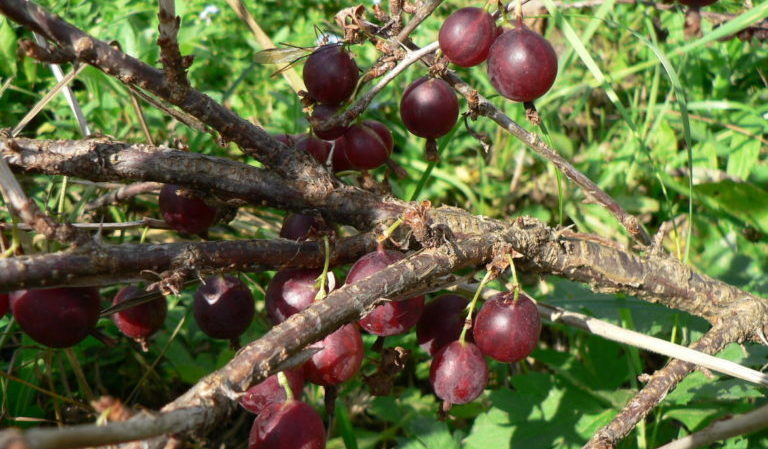
Prune bushes are distinguished by thick and strong shoots, forming a thin, but spreading crown. They grow up to 1.5 m. Young shoots have light green bark, older ones - brown.
A medium-sized plant has leaves of openwork and glossy, rich emerald color. Flowers with white petals, bisexual, so the bushes do not need pollinating varieties. The first flowering occurs in early May. The crop is harvested within 2 years after planting. There are short thorns on the branches below.
Resistant to temperatures
The variety is not afraid of sudden temperature changes during spring or autumn frosts and tolerates frosts down to -35 ° C.
Moisture and drought resistance
The variety does not like drought, when there is a lack of moisture, it stops growing, and yields decrease. Due to stagnant water, the root system begins to rot, and the plant dies.
Disease and pest resistance
It is immune to powdery mildew, but can suffer from other fungal diseases. Often exposed to the invasion of gooseberry sawfly and shoot aphids.
Characteristics and description of fruits
Prune has large or medium oval berries weighing up to 5 g. As they mature, their color changes from green to black. There is a small waxy bloom on the thin skin, underneath is a juicy and tender pulp with two small bones. The berries have a rich, sweet taste with a slight sourness. Ripening begins at the end of June and lasts until August. The yield increases every year, from one bush you can collect 3-4 kg of berries.
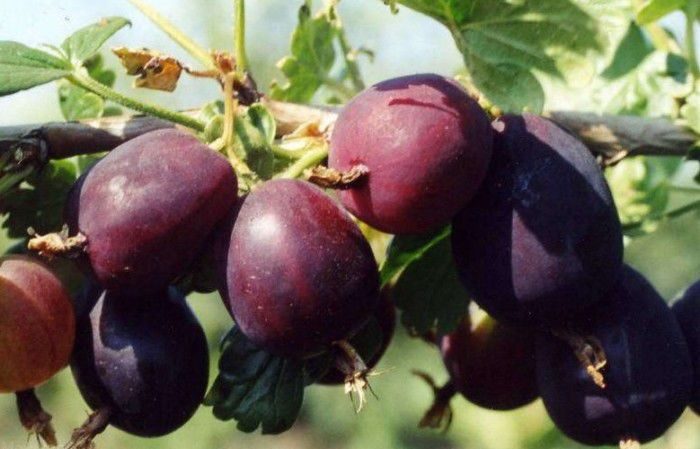
Application area
Fruit Prunes are suitable for fresh consumption, freezing, home preservation (compotes, jams), used in the preparation of wine and tinctures.
Advantages and disadvantages of the variety
Of the advantages of the variety, they note:
- small, compact bushes;
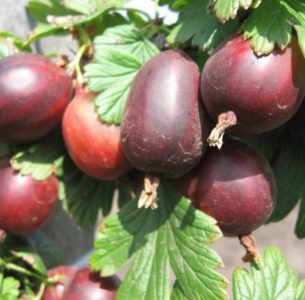
- good yield indicators;
- high taste of berries;
- unpretentious care and growing;
- frost resistance;
- adaptability to adverse conditions;
- self-pollination;
- a small number of thorns;
- universality of application.
Among the disadvantages are the variety of berries (3-5 g) and gradual ripening, which excludes a one-time harvest.
Growing technology
With regard to Prunes, cultivation and care agrotechnical techniques do not require much effort.
Optimal conditions
For this gooseberry, the southern part of the site with good lighting is selected. There should be no tall trees or buildings nearby, since the plant does not like shading and does not develop well in such conditions. It is worth avoiding the soil prone to waterlogging, the variety does not like excess moisture, which is why it often gets sick. Close location of groundwater to the surface (80-120 cm) is not allowed.
The best conditions are loamy or sandy loamy soil with neutral acidity (5-7 pH).
Do not plant gooseberries on an area where currants or raspberries were previously grown. Plant root systems are similar in structure and size, so the soil will lack nutrients. In addition, crops share common pests and diseases.
Reference. The bushes are planted in one line along the fences, which will later serve as a support for tying.
Terms and rules of landing
The variety is planted in early autumn so that the sprouts have time to take root and adapt to open ground. Planting is carried out in the spring, but only if cuttings were used.

Landing rules:
- The root system of seedlings is soaked for 24 hours in "Kornevin" - a root formation stimulator.
- The pits for planting are prepared in width and length by 50 cm, 40 cm deep. Maintain a distance between neighboring bushes 120-150 cm, and between the rows - 2 m.
- Pour 5 kg of compost or humus mixed with 1 tbsp into each hole. ash. Fertilizers are added to a part of the dug soil and poured with a bucket of water.
- A seedling is placed in the center of the hole, deepening the root collar by 5 cm. The soil is tamped and mulched with peat, sawdust, film or agrofibre.
- Shoots are cut, leaving 4-5 buds on each.
Further care
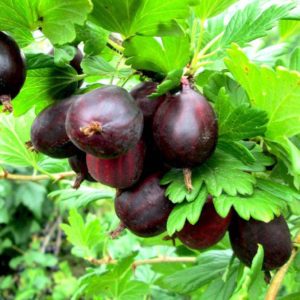
Basic plant care techniques:
- Watering... Young seedlings are watered once a week until the bushes take root. Adult plants need watering 3-4 times per season (1-2 buckets each): before and after flowering, during berry pouring and in autumn. If the summer is rainy, watering is carried out less often, and during drought, on the contrary, it is increased.
- Pruning produced in spring for sanitary purposes. Sick and dry branches are removed. Fruits form on two- and three-year-old stems, so older shoots are cut off so that the plant does not waste energy.
- Fertilizers bring in for the third season. Before that, the bushes have enough nutrients from top dressing when planting, otherwise they will grow, and they will not begin to bear fruit. Gooseberries love liquid organics like mullein solution (1:10) or chicken droppings (1:20).
Possible problems, diseases, pests
In early spring, the variety can be affected by goblet rust and anthracnose, therefore, before budding, the bushes are treated with Bordeaux liquid, and the soil around them is disinfected with Topaz or Agrolekar.
Every autumn leaves and branches must be removed, the soil is dug up or the top layer is replaced.
Of insects are dangerous:
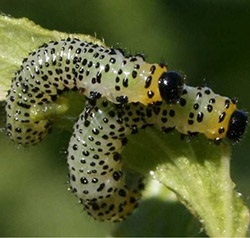
- Shoot aphid. Every 2 weeks, the bushes are sprayed with a solution of tobacco, dandelion or a soap-ash mixture.
- Fire. From the moment the snow completely melts and until mid-June, the gooseberries are mulched with oilcloth so that the hatched butterflies cannot get out of the ground.
- Gooseberry sawfly... Before the start of sap flow, in early or mid-March, the bushes are watered with boiling water, destroying the larvae wintering in the ground.
If pests nevertheless appear, the affected branches and leaves are cut and burned, and the bushes are treated with a solution of soap and ash, or ready-made preparations are used: Karbofos, Actellik, Nitrofen.
Wintering
In autumn, potash fertilizers are applied to increase immunity, and gooseberry stalks are covered with sawdust or hay. The oilcloth is pulled from above, avoiding pinching the stems.
Features of cultivation depending on the region
In arid regions, provide regular watering and make sure that the soil does not dry out.
In the northern regions, it is imperative to cover the bushes with agrofibre, especially if the winter is with little snow, with strong winds.
Reproduction

Gooseberry Prunes are propagated by:
- By dividing the bush. An adult plant in the fall is divided into 2-3 parts, detaching the lateral roots and placing it in open ground.
- Layers. These are young and strong shoots near the mother bush. They are prepared in spring, watered during the season, and separated and transplanted in autumn. to a permanent place.
Pollinating varieties
The prune gooseberry variety is self-fertile, so it does not need pollinators.
Reviews of summer residents
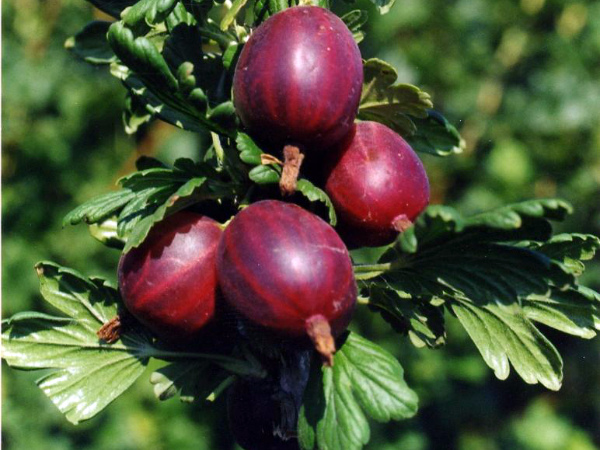
Gardeners praise this variety, noting its taste and unpretentiousness.
Lyudmila Smirnova, Moscow region: “As in the descriptions of the variety in reference books, Prune tolerates long winters and spring frosts well, and is not afraid of severe frosts. Thanks to the minimum number of thorns, it is easy to harvest, which we eat fresh. We remove the berries gradually, so we eat gooseberries throughout the summer. "
Ivan Lotyshin, Ural: “I was pleased with the frost resistance of the variety, frosts at -30 ° C the gooseberry tolerates without problems. I make wine from berries, mix them with grapes. For 5 years of cultivation, the bushes did not hurt even once, I spill the soil with boiling water in the spring, and in the fall I remove the top layer of the soil and replace it with a new one mixed with wood ash. It repels insects and fungus. ".
Conclusion
The Prune gooseberry variety is easy to grow even for an inexperienced gardener. The gradual ripening of sweet-sour berries provides fresh fruits throughout the summer. Due to its good frost resistance, the variety is successfully grown in the northern regions of Russia.